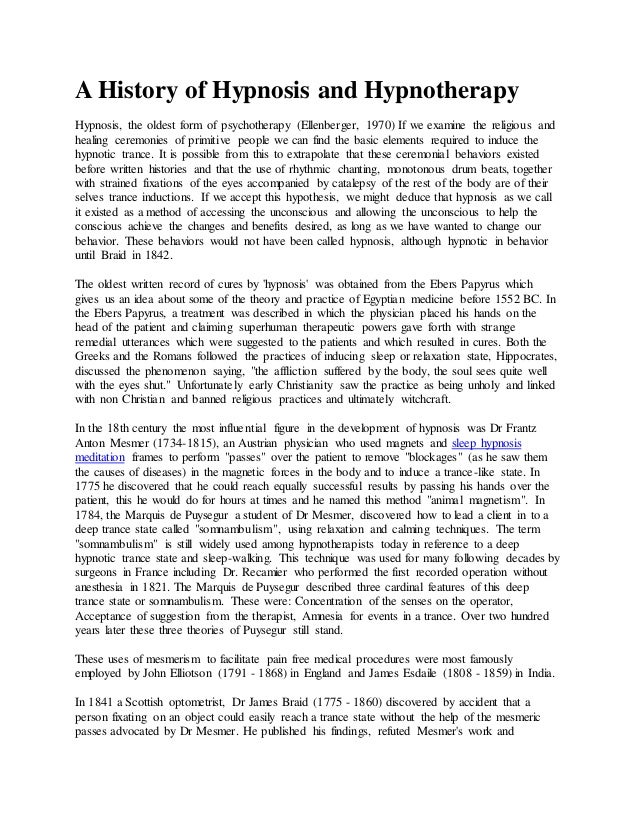
sleep hypnosis meditation
- 1. A History of Hypnosis and Hypnotherapy Hypnosis, the oldest form of psychotherapy (Ellenberger, 1970) If we examine the religious and healing ceremonies of primitive people we can find the basic elements required to induce the hypnotic trance. It is possible from this to extrapolate that these ceremonial behaviors existed before written histories and that the use of rhythmic chanting, monotonous drum beats, together with strained fixations of the eyes accompanied by catalepsy of the rest of the body are of their selves trance inductions. If we accept this hypothesis, we might deduce that hypnosis as we call it existed as a method of accessing the unconscious and allowing the unconscious to help the conscious achieve the changes and benefits desired, as long as we have wanted to change our behavior. These behaviors would not have been called hypnosis, although hypnotic in behavior until Braid in 1842. The oldest written record of cures by 'hypnosis' was obtained from the Ebers Papyrus which gives us an idea about some of the theory and practice of Egyptian medicine before 1552 BC. In the Ebers Papyrus, a treatment was described in which the physician placed his hands on the head of the patient and claiming superhuman therapeutic powers gave forth with strange remedial utterances which were suggested to the patients and which resulted in cures. Both the Greeks and the Romans followed the practices of inducing sleep or relaxation state, Hippocrates, discussed the phenomenon saying, "the affliction suffered by the body, the soul sees quite well with the eyes shut." Unfortunately early Christianity saw the practice as being unholy and linked with non Christian and banned religious practices and ultimately witchcraft. In the 18th century the most influential figure in the development of hypnosis was Dr Frantz Anton Mesmer (1734-1815), an Austrian physician who used magnets and sleep hypnosis meditation frames to perform "passes" over the patient to remove "blockages" (as he saw them the causes of diseases) in the magnetic forces in the body and to induce a trance-like state. In 1775 he discovered that he could reach equally successful results by passing his hands over the patient, this he would do for hours at times and he named this method "animal magnetism". In 1784, the Marquis de Puysegur a student of Dr Mesmer, discovered how to lead a client in to a deep trance state called "somnambulism", using relaxation and calming techniques. The term "somnambulism" is still widely used among hypnotherapists today in reference to a deep hypnotic trance state and sleep-walking. This technique was used for many following decades by surgeons in France including Dr. Recamier who performed the first recorded operation without anesthesia in 1821. The Marquis de Puysegur described three cardinal features of this deep trance state or somnambulism. These were: Concentration of the senses on the operator, Acceptance of suggestion from the therapist, Amnesia for events in a trance. Over two hundred years later these three theories of Puysegur still stand. These uses of mesmerism to facilitate pain free medical procedures were most famously employed by John Elliotson (1791 - 1868) in England and James Esdaile (1808 - 1859) in India. In 1841 a Scottish optometrist, Dr James Braid (1775 - 1860) discovered by accident that a person fixating on an object could easily reach a trance state without the help of the mesmeric passes advocated by Dr Mesmer. He published his findings, refuted Mesmer's work and
- 2. inaccurately named his discovery "hypnotism" based on the Greek word "Hypnos" which means "sleep". This was an unfortunately choice as hypnosis is not sleep, however the name has remained and mesmerism became hypnotism.